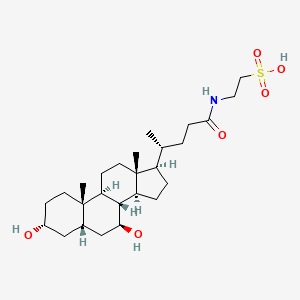| MeSH term | MeSH ID | Detail |
|---|---|---|
| Hypertension | D006973 | 115 associated lipids |
| Insulin Resistance | D007333 | 99 associated lipids |
Tauroursodeoxycholic acid
Tauroursodeoxycholic acid is a lipid of Sterol Lipids (ST) class. Tauroursodeoxycholic acid is associated with abnormalities such as Hyperglycemia, Obesity, Wiskott-Aldrich Syndrome, neurogenic hypertension and Cholestatic liver disease. The involved functions are known as Cell Death, Apoptosis, Homeostasis, Process and mRNA Expression. Tauroursodeoxycholic acid often locates in Body tissue, Endoplasmic Reticulum, Hepatic, Blood and Protoplasm. The associated genes with Tauroursodeoxycholic acid are Homologous Gene and Mutant Proteins. The related lipids are cholanic acid, taurolithocholic acid 3-sulfate, Sterols, 7-dehydrocholesterol and tauromuricholic acid. The related experimental models are Disease model.
Cross Reference
Introduction
To understand associated biological information of Tauroursodeoxycholic acid, we collected biological information of abnormalities, associated pathways, cellular/molecular locations, biological functions, related genes/proteins, lipids and common seen animal/experimental models with organized paragraphs from literatures.
What diseases are associated with Tauroursodeoxycholic acid?
Tauroursodeoxycholic acid is suspected in Endothelial dysfunction, Hyperglycemia, Obesity, neurogenic hypertension, Cholestatic liver disease, Heart failure and other diseases in descending order of the highest number of associated sentences.
Related references are mostly published in these journals:
- Diabetes (3)
- Am. J. Physiol. Heart Circ. Physiol. (1)
- Am. J. Physiol. Lung Cell Mol. Physiol. (1)
- Others (5)
| Disease | Cross reference | Weighted score | Related literature |
|---|
Possible diseases from mapped MeSH terms on references
We collected disease MeSH terms mapped to the references associated with Tauroursodeoxycholic acid
PubChem Associated disorders and diseases
What pathways are associated with Tauroursodeoxycholic acid
There are no associated biomedical information in the current reference collection.
PubChem Biomolecular Interactions and Pathways
Link to PubChem Biomolecular Interactions and PathwaysWhat cellular locations are associated with Tauroursodeoxycholic acid?
Visualization in cellular structure
Associated locations are in red color. Not associated locations are in black.
Related references are published most in these journals:
| Location | Cross reference | Weighted score | Related literatures |
|---|
What functions are associated with Tauroursodeoxycholic acid?
Related references are published most in these journals:
| Function | Cross reference | Weighted score | Related literatures |
|---|
What lipids are associated with Tauroursodeoxycholic acid?
Related references are published most in these journals:
| Lipid concept | Cross reference | Weighted score | Related literatures |
|---|
What genes are associated with Tauroursodeoxycholic acid?
Related references are published most in these journals:
| Gene | Cross reference | Weighted score | Related literatures |
|---|
What common seen animal models are associated with Tauroursodeoxycholic acid?
Disease model
Disease model are used in the study 'Bile Acids Reduce Prion Conversion, Reduce Neuronal Loss, and Prolong Male Survival in Models of Prion Disease.' (Cortez LM et al., 2015).
Related references are published most in these journals:
| Model | Cross reference | Weighted score | Related literatures |
|---|
NCBI Entrez Crosslinks
All references with Tauroursodeoxycholic acid
Download all related citations| Authors | Title | Published | Journal | PubMed Link |
|---|---|---|---|---|
| Yang Z et al. | Quercetin induces endoplasmic reticulum stress to enhance cDDP cytotoxicity in ovarian cancer: involvement of STAT3 signaling. | 2015 | FEBS J. | pmid:25611565 |
| Cortez LM et al. | Bile Acids Reduce Prion Conversion, Reduce Neuronal Loss, and Prolong Male Survival in Models of Prion Disease. | 2015 | J. Virol. | pmid:25972546 |
| Sommerfeld A et al. | Tauroursodeoxycholate Protects Rat Hepatocytes from Bile Acid-Induced Apoptosis via β1-Integrin- and Protein Kinase A-Dependent Mechanisms. | 2015 | Cell. Physiol. Biochem. | pmid:26044599 |
| Bikbova G et al. | Altered Expression of NF- κ B and SP1 after Exposure to Advanced Glycation End-Products and Effects of Neurotrophic Factors in AGEs Exposed Rat Retinas. | 2015 | J Diabetes Res | pmid:26078979 |
| Cai Z et al. | Involvement of Endoplasmic Reticulum Stress-Mediated C/EBP Homologous Protein Activation in Coxsackievirus B3-Induced Acute Viral Myocarditis. | 2015 | Circ Heart Fail | pmid:25985795 |
| Oishi N et al. | XBP1 mitigates aminoglycoside-induced endoplasmic reticulum stress and neuronal cell death. | 2015 | Cell Death Dis | pmid:25973683 |
| Cheng S et al. | Pachymic acid inhibits growth and induces apoptosis of pancreatic cancer in vitro and in vivo by targeting ER stress. | 2015 | PLoS ONE | pmid:25915041 |
| Xu LH et al. | Critical Role of Endoplasmic Reticulum Stress in Chronic Intermittent Hypoxia-Induced Deficits in Synaptic Plasticity and Long-Term Memory. | 2015 | Antioxid. Redox Signal. | pmid:25843188 |
| Liu F et al. | Tauroursodeoxycholic acid attenuates inorganic phosphate-induced osteoblastic differentiation and mineralization in NIH3T3 fibroblasts by inhibiting the ER stress response PERK-eIF2α-ATF4 pathway. | 2015 | Drug Discov Ther | pmid:25788050 |
| Xia H et al. | Brain ACE2 overexpression reduces DOCA-salt hypertension independently of endoplasmic reticulum stress. | 2015 | Am. J. Physiol. Regul. Integr. Comp. Physiol. | pmid:25519733 |
